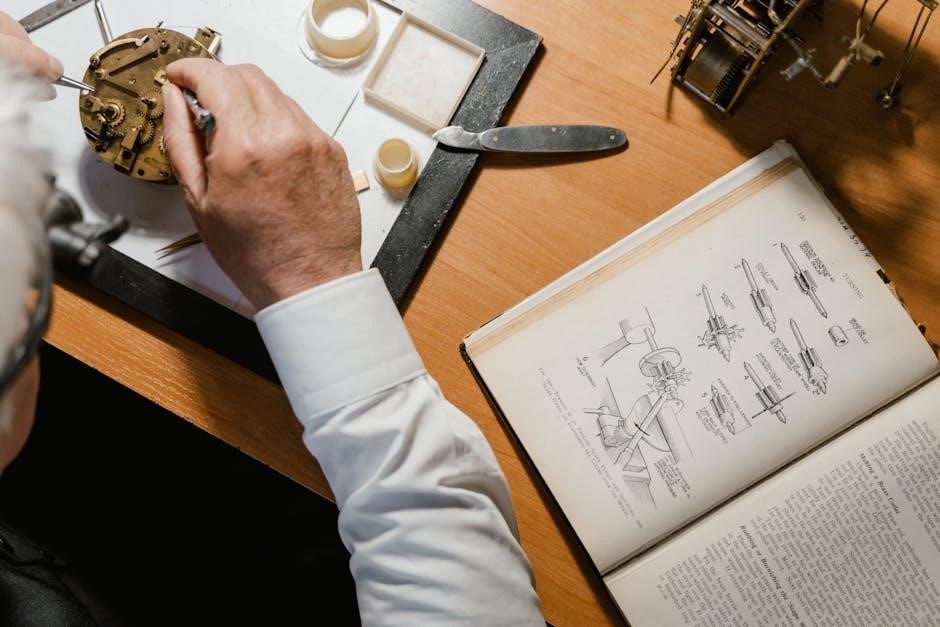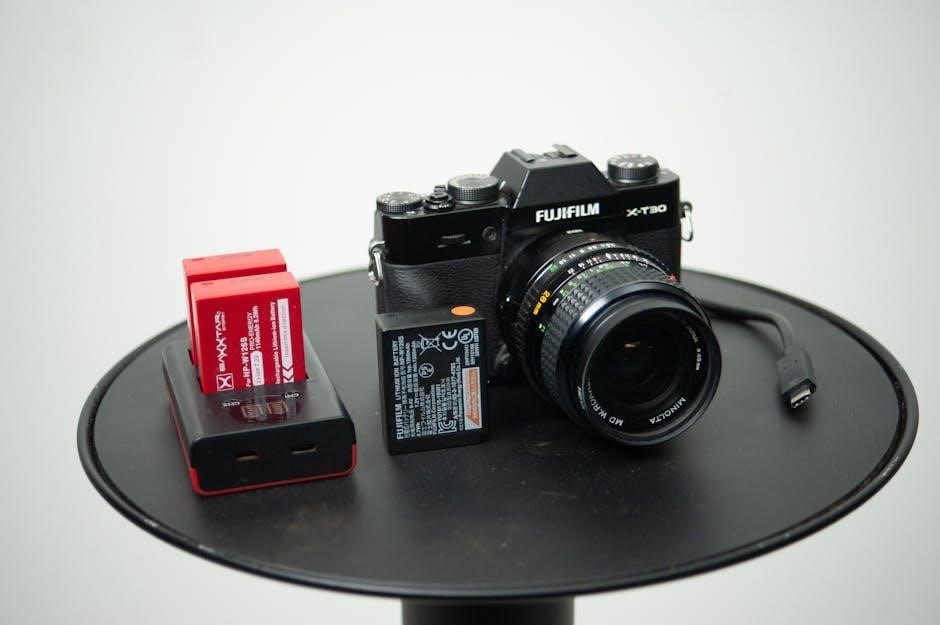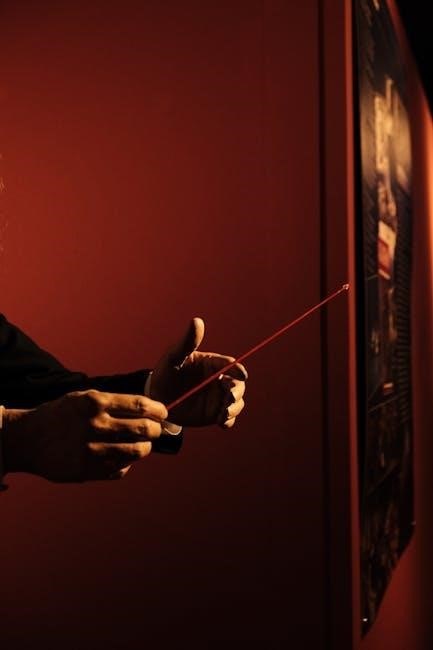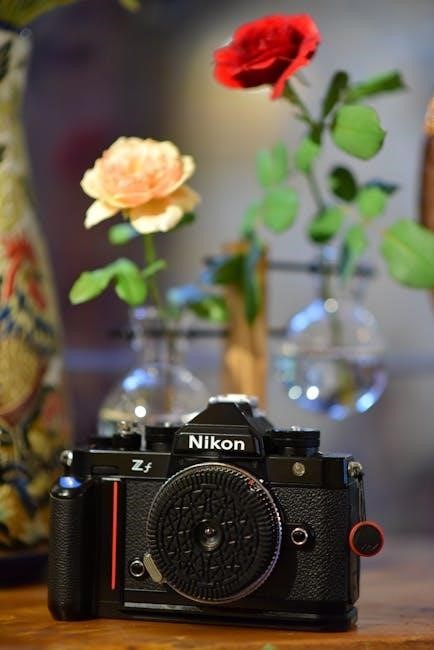The Nikon D50‚ introduced in 2005‚ is an entry-level DSLR designed for beginners and photography enthusiasts. It offers ease of use‚ robust features‚ and excellent value.
Overview of the Nikon D50
The Nikon D50‚ released in 2005‚ is a compact and lightweight entry-level DSLR designed for beginners and hobbyists. It features a 6.0MP APS-C CCD sensor‚ Nikon F-mount compatibility‚ and a user-friendly interface. The camera supports SD memory cards‚ a departure from Nikon’s usual CF cards‚ and offers a built-in flash with advanced sync modes. Weighing 620g‚ it is significantly lighter than other DSLRs in its class. The D50 was praised for its affordability‚ ease of use‚ and excellent image quality‚ making it a popular choice for those entering the world of DSLR photography.

Camera Build and Design
The Nikon D50 features a lightweight polycarbonate body‚ measuring 133 x 102 x 76mm and weighing 620g‚ designed for portability and ergonomic comfort.
Physical Dimensions and Weight
The Nikon D50 measures 133 x 102 x 76mm and weighs approximately 620g‚ making it a lightweight and compact DSLR. Its portable design ensures comfort during extended shoots‚ while its durable polycarbonate body withstands regular use. The camera is 163g lighter than the average semi-pro DSLR‚ enhancing its appeal for travel and everyday photography. This ergonomic build makes it easy to carry‚ perfect for photographers seeking a balance between performance and convenience.
Key Features and Ergonomics
The Nikon D50 features an intuitive control layout with well-placed buttons for easy access to settings. The ergonomic grip provides a comfortable hold‚ reducing fatigue during long sessions. The camera includes a built-in flash with various sync modes and a 420-segment metering system for accurate exposures. Its 2.0-inch LCD display offers clear image playback‚ while the pentamirror viewfinder ensures precise composition. These features‚ combined with a user-friendly interface‚ make the D50 an excellent choice for photographers seeking both functionality and ease of operation.

Image Sensor and Quality
The Nikon D50 is equipped with a 6.0MP APS-C CCD sensor‚ delivering crisp images with vibrant colors. It supports various resolutions and file formats‚ ensuring high-quality results for photographers.
6.0MP APS-C CCD Sensor
The Nikon D50 features a 6.0MP APS-C CCD sensor‚ providing excellent image quality with vibrant colors. The sensor’s size allows for a 1.5x crop factor‚ enhancing lens versatility. It captures images up to 3008×2000 pixels‚ suitable for large prints. The CCD technology ensures natural color reproduction and low noise levels‚ making it ideal for various lighting conditions. This sensor is a key component in delivering the D50’s impressive performance for its class.
Image Resolution and File Formats
The Nikon D50 captures images at resolutions of 3008×2000‚ 2256×1496‚ and 1504×1000 pixels‚ ensuring high-quality output. It supports JPEG formats (Fine‚ Normal‚ Basic) and RAW for uncompressed images. The camera uses SD memory cards‚ a departure from Nikon’s typical CF cards‚ with guaranteed compatibility with Sandisk‚ Toshiba‚ and Panasonic cards. This versatility in file formats and storage options makes the D50 flexible for both casual and advanced shooters‚ catering to various photographic needs and preferences effectively.

Autofocus System
The Nikon D50 features a 5-sensor AF system with CAM-900 module‚ offering AF-S‚ AF-C‚ and AF-A modes for precise focusing in various lighting conditions‚ down to -1 EV.
5-Sensor AF System and AF Modes
The Nikon D50’s 5-sensor AF system‚ utilizing the CAM-900 module‚ provides reliable autofocus performance. It supports AF-S (Single Servo) for stationary subjects‚ AF-C (Continuous Servo) for moving subjects‚ and AF-A‚ which automatically switches between the two modes. The system operates as low as -1 EV‚ ensuring focus in low-light conditions. The AF modes are selected via the camera menu‚ while the front switch toggles between AF and manual focus‚ offering flexibility for various shooting scenarios.

Metering and Exposure Control
The Nikon D50 features a 420-segment RGB sensor for accurate metering‚ offering 3D Color Matrix‚ Center-Weighted‚ and Spot modes. It ensures precise exposure control across various lighting conditions.
420-Segment Metering System
The Nikon D50 employs a 420-segment RGB sensor for metering‚ providing precise exposure calculations. This system supports 3D Color Matrix‚ Center-Weighted‚ and Spot metering modes‚ ensuring accuracy in diverse lighting scenarios. The 3D Color Matrix mode considers color and brightness for balanced exposures‚ while Center-Weighted focuses on the central area. Spot metering allows for precise measurement of specific subjects‚ enhancing control over lighting dynamics. This advanced system helps achieve consistent and professional-looking results‚ catering to both casual and advanced photographers. The metering system is a key feature that elevates the D50’s performance.
Exposure Modes and White Balance
The Nikon D50 offers a range of exposure modes‚ including Program (P)‚ Shutter-Priority (S)‚ Aperture-Priority (A)‚ and Manual (M)‚ providing flexibility for both casual and professional photographers. Scene modes‚ such as Night Portrait and Child‚ enhance versatility. White balance options include preset settings and a white card customization feature‚ though direct fine-tuning is absent; The camera also supports white balance bracketing‚ capturing three variations of a shot. These features make the D50 adaptable to diverse lighting conditions‚ catering to a wide range of photographic needs.

Viewfinder and LCD Display
The Nikon D50 features a pentamirror viewfinder and a 2.0-inch LCD with 130‚000 pixels for clear image preview and menu navigation‚ enhancing user experience and shooting precision.
Pentamirror Viewfinder and LCD Specs
The Nikon D50’s pentamirror viewfinder provides a clear optical path for precise framing‚ while the 2.0-inch LCD offers 130‚000 pixels for sharp previews. The LCD supports image playback‚ menu navigation‚ and histogram display‚ aiding in exposure adjustments. Although it lacks RGB histogram functionality‚ the display is sufficient for most users. The viewfinder is compact yet functional‚ ensuring an immersive shooting experience without unnecessary bulk‚ making it ideal for entry-level photographers who value simplicity and effectiveness in their workflow.

Additional Features
The Nikon D50 includes a built-in flash‚ remote control compatibility‚ and EN-EL3 battery support‚ offering versatility for various shooting needs and enhancing user convenience effectively.
Flash and Sync Modes
The Nikon D50 features a built-in i-TTL flash with a guide number of 15/49 (ISO 200)‚ offering excellent illumination for various lighting conditions. It supports multiple sync modes‚ including front-curtain sync‚ slow-sync‚ and rear-curtain sync‚ providing flexibility for creative photography. The flash system also includes red-eye reduction and a wide range of wireless and remote flash capabilities. However‚ the built-in flash cannot act as a commander for external Speedlights‚ limiting advanced multi-flash setups. Despite this‚ the D50 is compatible with Nikon’s external Speedlight system for enhanced lighting control.
Remote Control and Lens Compatibility
The Nikon D50 supports the optional ML-L3 wireless infrared remote‚ enabling convenient shutter release from a distance. This feature is ideal for minimizing camera shake and self-portraits. The camera is compatible with Nikon’s F-mount lenses‚ including older AF models‚ making it versatile for various photography needs. However‚ it cannot use the MS-D70 battery holder for CR2 batteries‚ limiting power options. The D50’s compatibility with a wide range of lenses ensures flexibility for photographers to explore different shooting styles and preferences.

Power and Battery Life
The Nikon D50 uses the EN-EL3 battery‚ offering up to 2‚000 shots without flash and 400 shots with frequent flash use‚ ensuring reliable performance for extended shoots.
EN-EL3 Battery and Shooting Capacity
The Nikon D50 is powered by the EN-EL3 battery‚ providing up to 2‚000 shots without flash and 400 shots with frequent flash use. This lithium-ion battery ensures reliable performance for extended shooting sessions. The camera also supports the optional MS-D70 battery holder for CR2 batteries‚ offering flexibility for photographers who need additional power options. With its efficient energy management‚ the D50 delivers consistent performance‚ making it a dependable choice for various photography needs.

Package and Pricing
The Nikon D50 was initially priced at $750 for the body‚ $900 with an 18-55mm lens‚ and $1‚150 with both 18-55mm and 55-200mm lenses‚ offering great value for its quality and features.
Kit Lens and Accessories
The Nikon D50 kit includes an AF-S DX Zoom-Nikkor 18-55mm f/3.5-5.6G ED lens‚ ideal for everyday photography. Additional accessories like the EN-EL3 battery‚ MH-18a charger‚ and DK-20 eyecup are provided. The camera supports SD memory cards and is compatible with optional remote controls such as the ML-L3. A range of lenses‚ including the 55-200mm‚ can be purchased separately‚ enhancing versatility for various shooting needs.
Price Point and Value
Initially priced at $750 for the body and $900 with the 18-55mm lens kit‚ the Nikon D50 offers excellent value for its features. Its affordability made it accessible to beginners while delivering professional-grade image quality. Over time‚ its price decreased‚ making it an even more attractive option. Compared to higher-end models like the D70‚ the D50 provides significant cost savings without compromising performance‚ making it a standout choice for photographers seeking quality without a hefty investment.
The Nikon D50‚ introduced in 2005‚ is a user-friendly DSLR ideal for beginners and hobbyists‚ offering excellent image quality at an affordable price point.
Final Thoughts on the Nikon D50
The Nikon D50 stands out as a reliable‚ user-friendly DSLR‚ perfect for beginners and enthusiasts. Its 6.1MP sensor delivers sharp images‚ while features like the 420-segment metering system and 5-sensor autofocus ensure versatility. The lightweight design and intuitive interface make it accessible‚ yet powerful‚ for capturing stunning photos. Although surpassed by newer models‚ the D50 remains a solid choice for those seeking an affordable entry into DSLR photography without compromising on quality.



